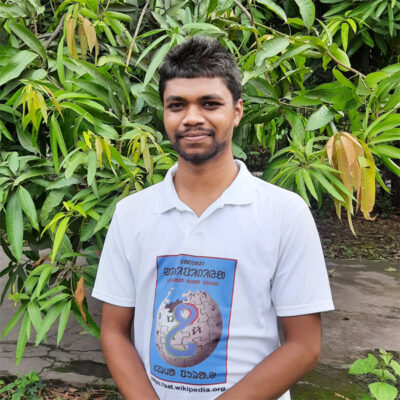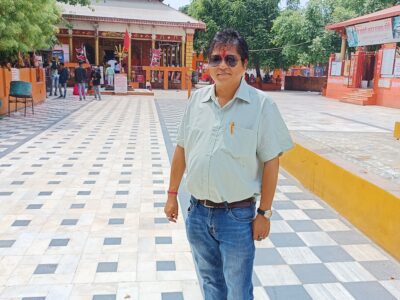
Photo courtesy of Prasanta Hembram and used with permission.
As part of our ongoing series highlighting the work of activists promoting Asian languages in digital spaces, we would like to feature Prasanta Hembram (@prasantahembram) from India.
Hembram works to make the Santali language, spoken through much of East India, more readily available online.
Rising Voices recently interviewed him by email to learn more about his perspectives on his language finding its place in online spaces.
Rising Voices (RV): Please tell us about yourself and your language-related work.
Prasanta Hembram (PH): I have recently completed my Post Graduation in Life Science (Botany). I fill my leisure time by planning ways for the development of the Santali language online.
During these 3 years, I found many projects for my language and for other languages too. Santali is my mother language and I also know English, Hindi, Odia, Sambalpuri, and Ho languages. I have been taught Santali at home. I haven't attended any formal education in Santali language, though I am planning to do so. I have learned to write and type from the year 2018 by learning from Youtube videos, attending offline seminars organized by ASECA, AISWA etc. Also, in 2018 I started to volunteer with open source projects Wikipedia, Common Voice, Google Crowdsource, Tatoeba, Mozilla Translation team, etc. which will directly contribute to the development of Santali Community in the near future. For more information regarding open projects for Santali language please read my blog post.
RV: What is the current state of your language both online and offline?
PH: I would say very little content is available online, and plenty of work is done offline. A large number of people are illiterate, which is a big challenge. However, every challenge can be dealt with. So, there are many social activists who are visiting people village to village to make them aware of their rights and explain to them the importance of education and taking part in the development of Santali language. Offline events are organized as well.
More work is also done for increasing the amount of quality content online at the ground level (Offline/online classes, doubt session etc). The Indian government played a vital role for Technology and Content support in Santali language too. They have made fonts, localised software in Santali language and many more, they also created an online Vikaspedia.
The Wikimedia Foundation supported the Santali language by giving us space in their organization. We are called “Wikimedians of Santali Language User Group“, which I'm also a part of. We promote Santali Language and spread its written content on the Internet. We have contributors from three countries: Bangladesh, India and Nepal.
Also, various independent researchers are working on the Santali language.
The state of our language is very good offline as plenty of books are published and are praised (Ex: Mann ki Baat: PM Modi praises Purulia professor for translating Indian Constitution into Santhali language, know who is Professor Tudu). The Sahitya Academy, ASECA, AISWA organizations work for the development of language.
In regards to its online presence, educational materials are not available–if any are available then they are for research purposes. Due to low literacy, fewer people are writing online and offline content. Those who are highly qualified don't know much about language technologies, they exist but there is a need for awareness and digital literacy. Entertainment materials are more available than education-related videos.
RV: What are your motivations for seeing your language present in digital spaces?
PH: I feel very motivated when I find my language content online, more people are typing and providing knowledge to people in their tongue. This motivates me to share or contribute something from my side too. In fact I have learned to start writing in Santali online.
I also feel demotivated when no content is available for which I need in my tongue. This was the state when I was a teen. Now, I'm mature and know how to find loopholes and I'm discovering ways to fill them. In that direction, I discovered many open source projects. I think if we contribute to that then our future generations will benefit a lot.
The problem is very little data is available for Santali language online (other unofficial languages of India too), we as individuals can at least be able to crowdsource data as much as possible in our free time. Then researchers will be able to use our data and develop technologies for the benefit of our community.
Also, I'm trying to become financially independent through digital content in my mother tongue which is a big challenge. Recently I've been directly involved in such research work. Until now I have found no one who is financially independent with creating online Santali content.
RV: Describe some of the challenges that prevent your language from being fully utilized online
Illiteracy and lack of digital awareness among literary people. People are not giving much attention to the generation of education related content online. The Adivasi peoples in India by and large have the lowest access to financial, governance, institutional, linguistic and technical support for using their language for knowledge exchange.
The majority of people are poor and can't afford to buy a computer, though some can afford a smartphone. But, heavy tasks are not possible on a smartphone, which prevents them from making better content.
A lack of technical support leads to various content creators being demotivated.
Santali language script was introduced in 2008 in Unicode version 5.1. Even after 12 years, the Santali language is not available as an option to switch on in the major websites and apps like Google, Facebook, Twitter and Instagram or added as a language option. The Santali language was added as an option on request on Poeditor.com. Before that people were not able to give contributions in the Santali language.
Low online content sharing also yields in the availability of critical information in many Adivasi languages. Entertainment-related content being mostly multimedia, searchability and discoverability of such content is lower as opposed to textual content. There is a growing trend for independence—from social oppression by neighboring dominant communities—among many Adivasi peoples.
Disagreements among scholars on linguistic factors—such as the preference of one writing system over the other for Adivasi languages—have been detrimental for content growth. Similar linguistic conflicts and the resulting hateful posts on the internet have acted against emerging content creators.
Multiple writing systems being used for the same language beyond official use have an adverse impact on the language. Many more problems are there which we assume to be true. You can check more from the Hypothesis section.
RV: What concrete steps do you think can be taken to encourage younger people to begin learning their language or keep using their language?
PH: I follow the Use it or Lose it principle. It would be better if we use our language somewhere, instead of just documenting it. A few steps can be taken in my opinion, such as more participation is required for keeping this language active, like using typing, writing, speaking in daily life without hesitation and speaking language without shame.
Santali Wikipedia organizes various online Editathon competitions every month to write more articles in Santali language, which has increased participation.
Recently some online events were organized which increased more online participation for Google Crowdsource, where we are trying to bring the Santali language to google.
With personal effort I have translated a few popular Android apps which motivated some people to translate on their own, it's still increasing and is at nearly 20 apps now.
By means of online and offline events/programs we can generate awareness as we do now. Using our language on daily online tasks like social media can also be a big help. Focus should be shifted to creating online quality education content instead of just making entertainment videos.



